There is a wise maxim that was presented by German military strategist Helmuth von Moltke; “No battle plan survives contact with the enemy.” While this may seem to be an idea that applies to battlefield tactics, it can easily apply to our own personal lives and our ongoing desire to master the defensive handgun. There are many variables in a dangerous conflict that we may not be able to control yet many times our weaknesses are areas where we simply don’t prepare enough. In the realm of defensive handgun, the most commonly neglected area is in weapon manipulations for malfunctions and reloads. Many people are exceptional shots, but if their gun goes unexpectedly quiet, an internal “oh crap” surfaces and the scramble begins.
Malfunctions
I hear it all the time, “My gun never malfunctions.” Well, I am here to tell you that there is a word you need to add to that sentence … “yet.” Malfunctions are a real-world fact with firearms. The cause of these frustrations range from ammo issues to worn parts, but they are a reality we need to deal with. As a general rule, we classify handgun malfunctions in three ways; type one, type two and type three. There are certainly other malfunctions that can occur, but most issues outside these three tend to be catastrophic failures that require tools to remedy. The type one is also known as a failure to fire. It can be caused by several things but commonly it is a failure to completely seat the magazine. No round enters the chamber and we get a deafening “click” when we press the trigger. The remedy for this is simple. Move the gun closer to your torso in what we call your workspace. Firmly tap the magazine with your support side hand, grasp the slide and while angling the ejection port towards the ground, rack the slide. An easy-to-remember phrase is, “Tap-Rack-Roll.”
Now here comes some great news. As we move on to the type two malfunction, our clearance technique remains the same. The type two is a failure of the spent brass to completely clear the ejection port. Many times it turns into a stovepipe situation. Once we experience a dead trigger, we do the same technique. Bring the gun into your workspace, tap, rack and roll. This is why we roll the gun. It allows gravity to assist us in clearing out obstructions from the ejection port.
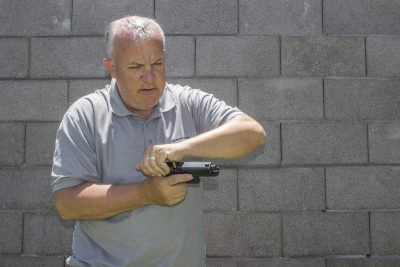
In a Type Two failure, you must cycle the slide and rotate the pistol to allow the jammed case to fall free.
With one and two out of the way we move onto type three. This is a double feed. Essentially, two bullets fighting for the same space in the gun. This is a little more time consuming and a great example of why practice matters. The trigger will once again be dead. Most shooters will already see that the slide is not all the way forward. We bring the gun into our workspace, now lock the slide to the rear. We need to get the mag out and have to take tension off of it to accomplish that. Once it is locked to the rear, release the magazine. You may retain it or discard it. While some groups train to ditch any magazine connected with a malfunction, I would caution against this unless you ALWAYS carry two additional magazines on you every day. You may need the rounds in that mag. With the mag out, firmly rack the slide three times to ensure the chamber is clear. Re-insert a magazine and rack the slide once again to reload the gun. Just like that you are back in the fight. There are certainly small variations on a theme with these techniques, but regardless of what version you choose – practice them.
Reload
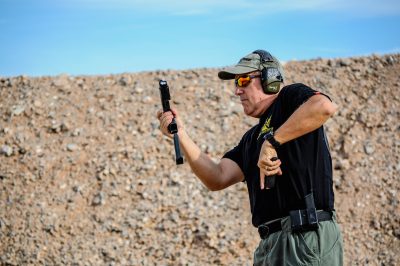
A clean and effective reload requires that you already have the spare mag on its way while clearing the empty one.
While we are in a quoting mode here let me share a gem from Ken Campbell at Gunsite, “Keeping your gun full of ammo is a problem…just not my problem.” The gist of this is that we should always work to keep our weapons topped off with full magazines if possible. The best way to do this is to use what are called tactical reloads. This is the replacement of a partially depleted magazine with a full magazine. It is carried out in the following fashion. Bring the gun into your workspace, eject the partially spent magazine into your hand and pocket it. As your hand now comes past your mag pouch grab a fresh mag and insert it into the gun. The technique is called one out and one in. There is another version of this where you get your fresh magazine in hand first then drop the partial into your palm. A little bit of gun yoga later and you have switched the mags. While it is true that your gun is without a full mag for a shorter period, this technique came to be when slender 1911 mages were the norm. If you are running Glock or other double stack mags it can be bulky. The choice is yours though. Just a quick note on the tactical reload. Much has been made of when you should do one. This is not a gun fighting component. There will be no “lull” in the battle. It is on or it is off. The only time you should ever do this is if you are 100% safe with no threats in proximity.
Last up we have the emergency reload. This is an empty magazine with a slide locked to the rear. This is a quick fix fortunately. Bring the gun into your workspace and index a fresh magazine. As you are pulling it out and bringing it towards the gun, eject the spent magazine. Now insert the fresh mag in one smooth firm motion, seating it solidly. With your support side hand, rack the slide and now the gun is loaded once again. There is a version of this technique that can be used on several pistols where you simply press down the slide lock and in doing so the gun goes back into battery. There are some pistols where this is a challenge so I teach a reach over and rack the slide technique because it works on all handguns.
[one_half]
[/one_half]
[one_half_last]
[/one_half_last]
Train
The problem with all of these techniques is that they are not glamorous. They are monotonous drills that are not nearly as enjoyable as shooting. They are crucial however and a failure to master them will keep you from being a well-rounded pistolero. As I say in classes, “You can be the best shooter in the world, but if you can’t keep your gun running you will become a bullet sponge.”
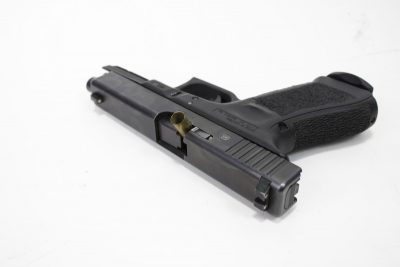
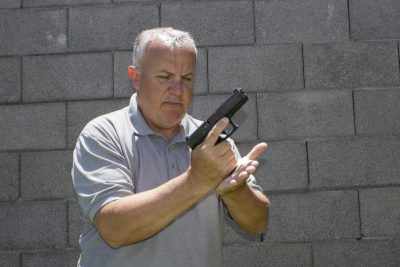
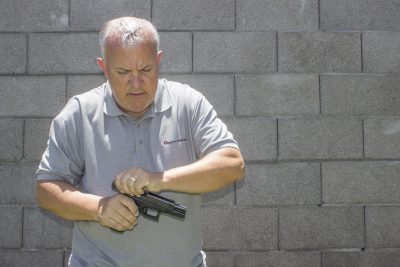
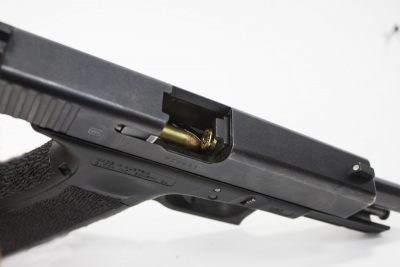
There are advantages and disadvantages to each type of firearm available for carry. If you want to complicate matters even further, we can add a derringer to the mix of options. Sure, with only (2) rounds they have extremely limited capacity, but if it’s a quality unit there’s even less that can go wrong than a revolver or auto. I’m not saying it’s my choice for a primary, but I do have a Bond Arms .410/.45LC that I carry sometimes as a back-up. There are (3) basic rules of carry that you should ALWAYS follow :
1) Be proficient with whatever you carry
2) Anything that can go wrong usually will, so carry a back-up
3) It won’t do you a damn bit of good if it’s at home in the safe or the console of your car – always carry. EVERY trip, EVERY time, ALL the time.
Stay safe !! It’s s crazy world and these are crazy times.
We constantly have others put dummy rounds in our mags so we won’t know when malfunctions occur and intentionally set up double feeds and stovepipes and the time spent clearing them counts in your overall time. Under stress you will do what you have been trained to do. If you don’t train you will just panic/freeze.
All civilian close-quarter engagements should start with “take cover.” If you haven’t yet taken cover by the time you have a failure or must reload, that’s the time to do so.
I’ll stick to my single action revolver. If You need so many rounds to hit Your target,get Yourself a shotgun!
How about multiple targets? It also seems like the people who do this to live (police, military) tend to use more than six most of the time. I’d rather have a few extra left when it’s over, than be caught standing there with my reloading gate open while it’s still on.
Type 1, type 2 and type 3 malfunctions? Why unnecessarily complicate stoppages based on what “type” it is. According to the article you can have a failure to fire, a stovepipe, and a double-feed. Why not just stick to calling them that? Especially when the author points out that there are THREE “types” of failures but only TWO “remedies”.
I believe Gunsite initiated the malfunction \”types\”, maybe the military. All firearms instructors use this jargon out of habit because that\’s how we were taught. But I agree with you – keep it simple.
Great article and you should SERIOUSLY practice malfunction drills! These malfunction drills are exactly what we trained our AZ state troopers to do for each malfunction (except on a type 3 we would rack twice instead of thrice). We did \”TAP, RACK, ROLL, ASSESS.\” We also taught them not to stand still if your weapon malfunctioned – take cover or at least take a step to the right or left so you\’re not a sitting duck while clearing your weapon, maybe take another step as you\’re returning to the gunfight to assess. Don\’t just stand there with a gun that won\’t shoot and make sure your muzzle is ALWAYS POINTED DOWNRANGE or in a safe direction. It\’s VERY easy to start muzzling your buddy next to you if you don\’t do these drills properly. The type 3 is the worst of all of them as there is no quick fix – even with the slide locked to the rear you may have to RIP the mag from your pistol and it can be a challenge! Take cover or move! Lastly, make sure you insert your spare mags in your pouch facing the same direction so that when you draw them, your left index finger of your support hand touches the front of the bullet (indexing). This makes it much easier to reload and complete these drills without looking down – your eyes should be downrange or on your adversary.NOBODY likes doing malfunction drills (well, no one I know) but if you practice them properly it may save your life one day – start slowly and do it right – speed will come. Buy a couple dummy rounds and insert them into your magazines at various locations and do it for real – you should have at least 3 mags to do these drills. You can practice this at home too with six dummy rounds – just be sure all live ammo is put away; all mags are empty and all you have present are marked dummy rounds. After the gunfight appears over – look left, right and to your rear. This helps make you aware of others and break any \”tunnel vision\” you may have developed. TRULY look – don\’t just go through the motions of turning your head quickly.Regarding tactical reloads: The way we taught it was to take cover (or a step or crouch), retrieve the fresh mag, bring it up to the mag you\’re going to remove, hit the mag release and drop the mag into your hand. Insert the fresh mag and make sure it seats all the way. Place the used mag in your belt or pocket – NOT back into your mag pouch. Again, practice slowly – speed will come. Use your best judgement on when to perform a tactical reload. On an empty gun or emergency reload, I too strongly encourage you to rack the slide and not try to use the mag release. Multiple reasons to do it this way.Before loading up, check each and every round you plan on carrying in your gun and for reloads. Inspect every round to be loaded visually for oddities (too long, too short, primer seated sideways, etc.). Insert each one into the chamber to ensure it fits.Some of you may know Ed Stock from Gunsite Academy: He\’s a friend who worked for my agency and was instrumental in developing these drills.For those of you carrying a revolver: Yes, you are less likely to experience a malfunction if you clean and maintain your revolver, HOWEVER you better be checking each and every round you plan on carrying in your gun and for reloads. You should first inspect every round visually for oddities (too long, too short, primer seated sideways, etc.). You also need to fit every single round into the cylinder to ensure they fit.
Does anyone know why a \”slash\” is also inserted when I place an apostrophe? This is annoying.
Just get a horse and buggy. Feed the horse and grease the axles. Cars have WAY TOO MANY PARTS They break down at the worst possible time. ANY MECHANICAL thing can break. Learn to live in the future
Chose your revolver carefully if you want the ” just as fast as a semi-auto” reloads mentioned above. Not every revolver is efficient, many speed loaders are not convenient to transport and access. You are reloading 6 to 7 rounds, not 15, so you may be reloading more frequently if you find yourself in an extended battle. You better be really good at reloads, being really smug about your reliable revolver without exceptional skills will increase your chances of being the “bullet sponge” mentioned in the article. Battles suck whether you have a revolver or semi-auto, mental stability and practiced skills are critical in every situation, even if you never fire a round.
\”Extended battle..?\” How quaint… Not realistic and most certainly from a scene out of an action movie but unless your in the military or are an urban-based police officer, one cylinder full of juice or one magazine primed to go will be sufficient.. I mean, look at the \”Armed Citizen\” monthly report in the NRA\’s \”American Rifleman\” magazine.. I cannot recall any of the defenders lobbing more than a couple of rounds downrange…
I carry a Taurus 617 .357 magnum seven round snub nose revolver. If it doesn’t go bang when I pull the trigger, simply pull it again! When my life is on the on the line, I don’t want to be dealing with malfunctions!!!
Can you see it now? Going thought all that when a mad man coming at you swinging ax! Get a good revolver! I like the Charter Arms 45 ACP Pit Bull. In double action, the hammer come back almost as far as in single. Some revolvers don’t do this and can misfire, but then just pull the trigger again or shoot it in single action mode.
Hope this helps. NO AUTO LOADERS FOR ME!
I’m with You Brother! I would rather have a pocket full of rocks as a plastic semi-auto! I’ll stick to my single action revolver. I don’t have to worry bout jamming and dropping my clips. Learn how to shoot and hit Your target and You don’t need 50 rounds!
Just get a revolver , practically no malfunctions and with practice can be reloaded just as fast as a semi-auto. Reliability is key in an altercation as well as placed shots. Pray and spray is not the answer.